If you’re a foodie or garlic fanatic who wants to save cash on trawling the farmers market, you may want to look into growing green garlic.
This young immature form of garlic has an ultra-short growing season, and an ultra-high price tag from specialty grocers.
Why not get your green fingers working and grow this delicious green for yourself?!
Garlic greens are probably one of the easiest plants to grow and cost you no more than a bulb of garlic.
So read our comprehensive growers guide that covers everything you need to know to harvest an abundant crop of this incredibly moreish delicacy!
What is green garlic?
Green garlic is simply young, or baby garlic – immature garlic plants that have bulbs that have not yet been divided.
This makes the entire garlic plant incredibly tender and easy to cook and eat. Like greens, but with a delightful garlicky pungency!
Sound like your kinda thing?
Read on to find out how you can grow garlic greens for cents on the dollar.
How to grow green garlic
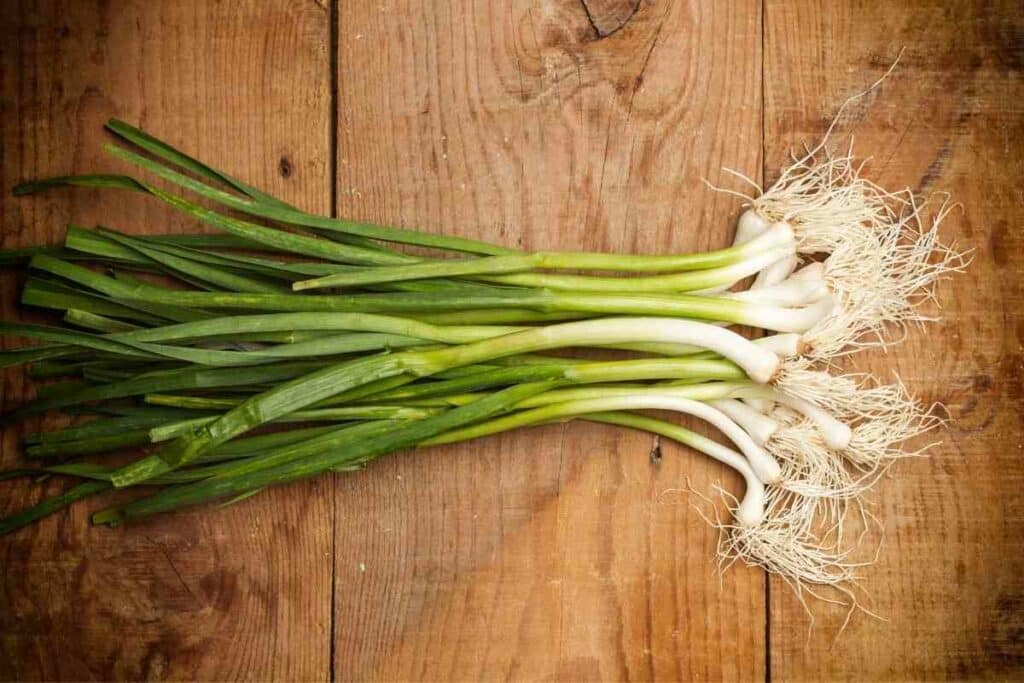
To grow green garlic, you simply have to master growing garlic and cut the long growing season it normally enjoys short, to harvest tender green shoots for your salads and stir-fries.
Normally garlic is sown in autumn, or winter but use a spring variety as you have a shorter growing period in mind.
What to Expect? You’ll find that growing garlic is incredibly easy and cheap as you are simply planting cloves and letting nature take its course.
Here are the steps you need to take for the best results.
Purchase certified garlic bulbs at your local garden center or online
You can plant regular garlic cloves that you have purchased from the store but the risk of introducing disease is higher than buying a certified variety that is disease-free.
Choose from softneck or hardneck garlic varieties
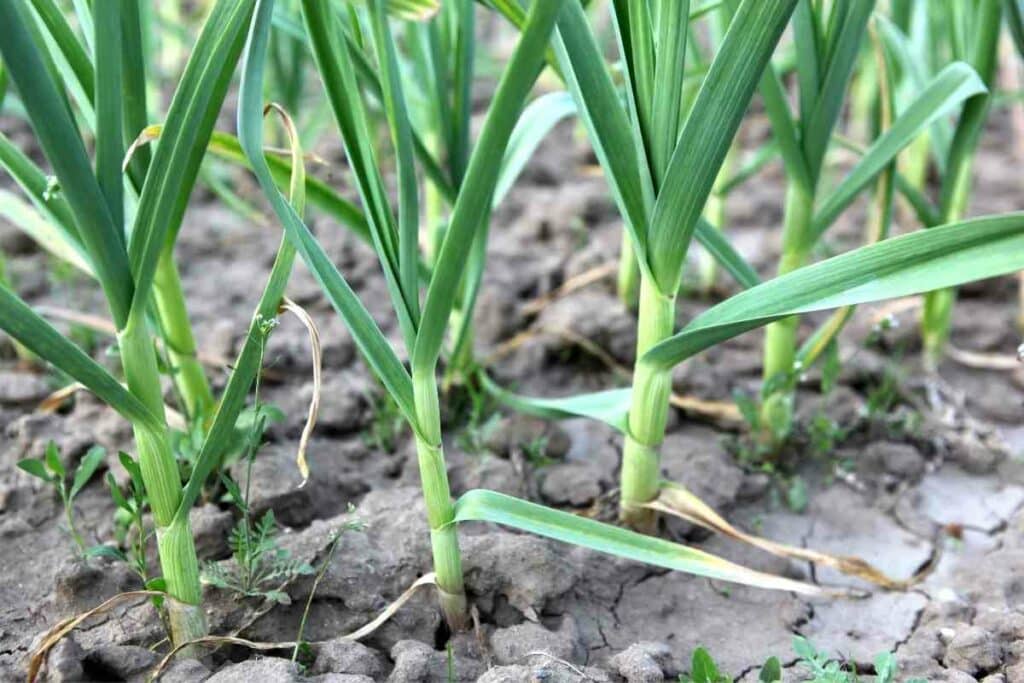
- Softneck garlic is the type of garlic you buy and use from the grocery store. It’s popular because it is highly productive, yielding large numbers of cloves. You’ll recognize the classic white paper-thin skin, that dries quickly for storage. It is ideal for growing garlic green but it will need protection in the winter as it does not tolerate frosts.
- Hardneck garlic varieties have fewer cloves in each bulb than soft-neck varieties. They are hardier and can be grown for their greens and delicious garlic scapes. The scapes are dramatically curling flower stalks with bulb-like head that is full of flavor. Use them in a similar way to greens.
- Elephant garlic is a bit more exotic (and expensive) but yields beautiful greens which are extremely tender and sweet.
Best garlic growing conditions
Garlic loves warmth and sun.
If you have a suitable location with fast-draining, fertile soil, you can plant your garlic in late autumn, and it won’t rot during the winter.
Make sure that the plot you use is weed-free and has no remaining summer crops in it. Feed the soil with a hearty forkful of manure that can be raked in.
Planting garlic cloves
Garlic is an excellent value crop because each clove gives rise to a whole garlic plant!
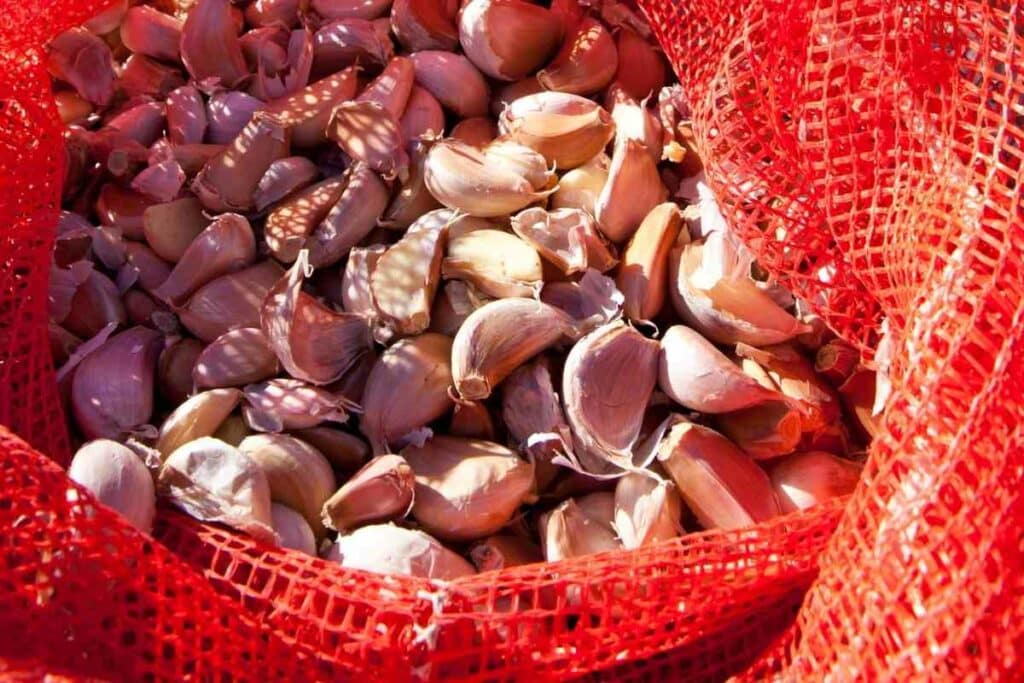
Here is the process:
- Take a bulb and break it up into individual cloves.
- Sow single cloves direct in the soil with the narrow end of the garlic pointing upwards, at least 2.5 centimeters from the surface.
- Plant your cloves in late autumn or early winter to take advantage of the cold period garlic needs to develop its bulbs properly.
- Use a dibber to make a hole in the soil or just push them in.
Alternatively, you can garlic off in pots.
You can also grow garlic successfully in pots and containers.
You’ll need a pot that is deep and at least 15 centimeters wide. Fill it with quality compost and sow 3 cloves per pot.
Protect your garlic
Give your garlic the best chance of yielding tender tasty greens by protecting your planted cloves:
- From birds: birds are just as gastronomically discerning as you when it comes to planted garlic and will eat cloves and shoot. Protect your bed by laying netting or fleece, which also keeps the cloves insulated from the cold. Don’t remove the netting until the shoots are at least 5 centimeters tall.
- From the cold: laying horticultural fleece provides welcome insulation from cold winter and helps to get the garlic growing early on in the Spring.
Feed your garlic
Your garlic is only going to get going with growing in the spring, so that is the time to start feeding your garlic.
When growth accelerates add a high nitrogen feed or more compost.
For garlic greens, feed between April and early May.
Watering your garlic
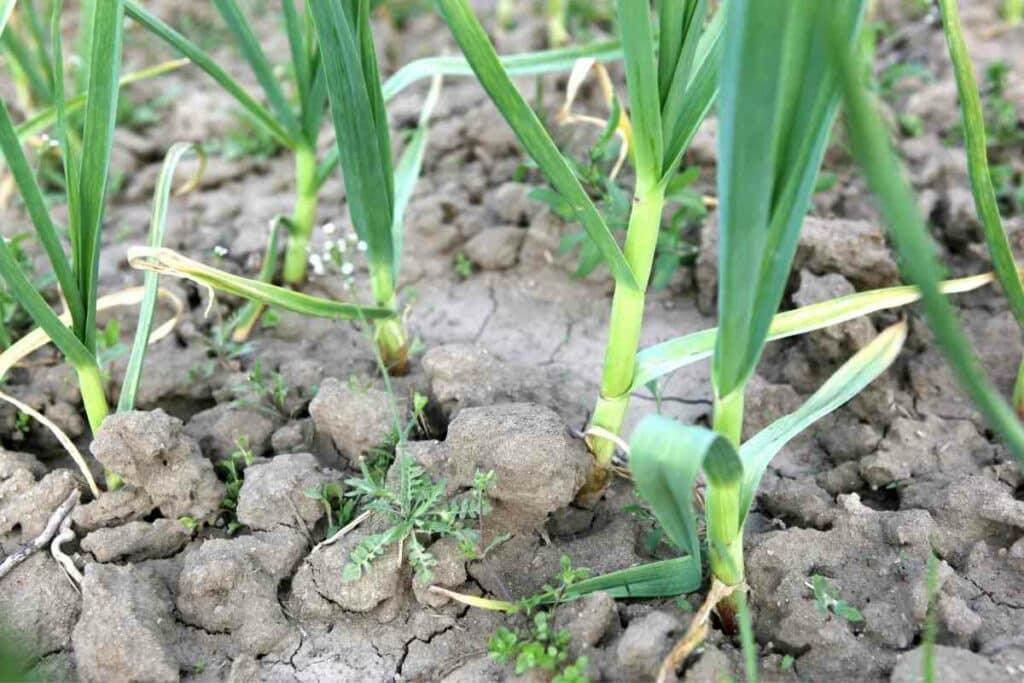
You’ll be relieved to know that for the most part, garlic needs very little intervention.
Start watering during spring and early summer and keep your greens green and moist while harvesting them.
For Garlic Greens – You should have harvested them before the foliage turns yellow as this is a sign that the bulbs are mature.
Weed your garlic
Weeding ensures that your garlic gets the water and nutrients it needs.
Hand weed between plants to prevent hoe damage.
Watch out for these common garlic pests and diseases
Garlic is extremely hardy so pests are not usually a major concern.
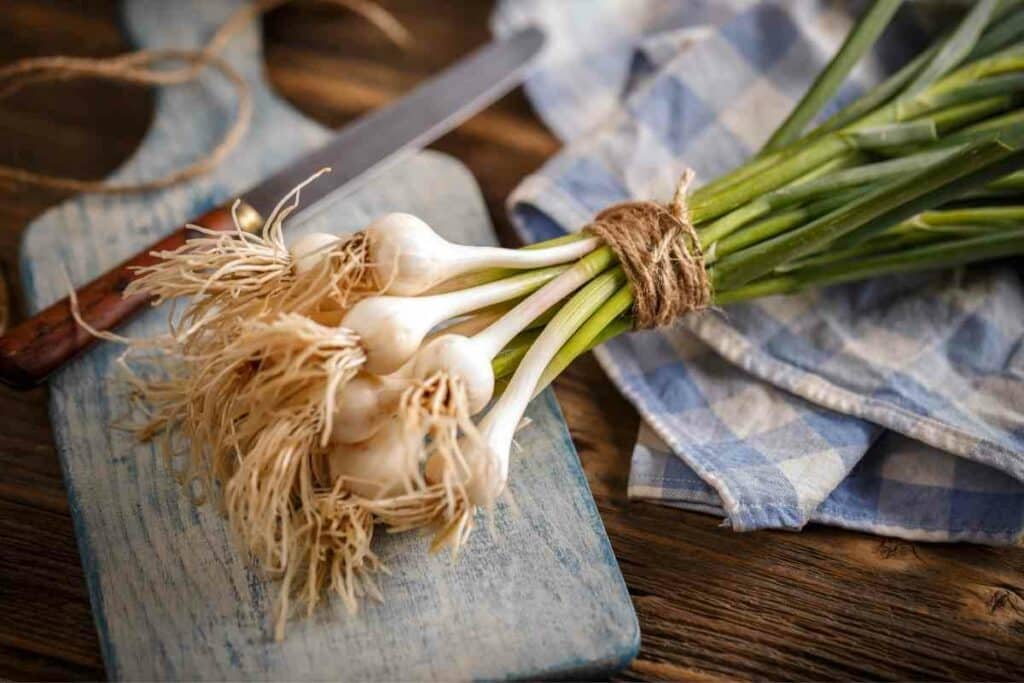
The main priority is vigilance as the diseases that get garlic greens often go undetected until it’s too late.
Here are two key garlic diseases to watch out for:
- Onion white rot: The organism that causes this disease comes from the soil. If you encounter onion rot you’ll need to grow your next set of garlic in containers as there is no way to eradicate this from the soil. It produces yellowing and dieback of your delicious greens, often mistaken for maturing garlic. When the garlic is dug up it has fungal growth and is black and rotten.
- Leek rust is a fungal infection that occurs in sustained damp weather. Again, there is die back of the foliage with orange pustules on your greens! The remedy is to harvest and use all affected plants as the garlic bulb should be unaffected.
To prevent these diseases, avoid planting garlic, leeks, or onions in the same place more frequently than every 3 years.
Get those greens! Harvesting garlic greens
The #1 piece of advice for harvesting garlic greens is not to wait too long.
You want these greens when they are tender and the bulb has not fully formed.
Wait, too long, and you’ll have a tougher bulb and greens.
When do I harvest garlic greens?
Look for garlic greens in late spring when the foliage is tall and green.
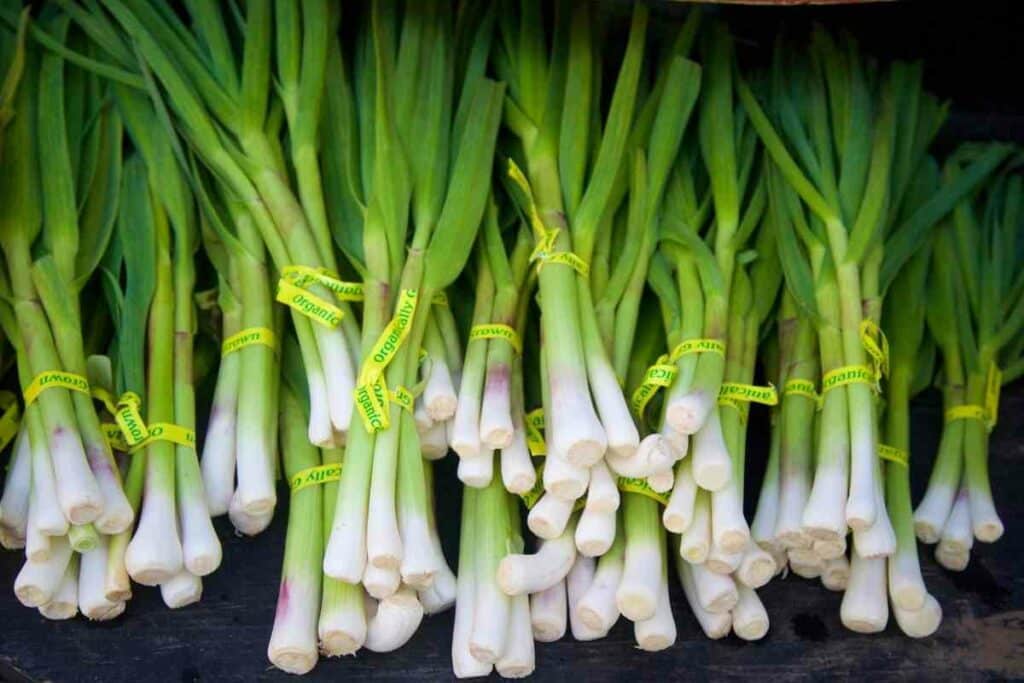
Between May and late June is likely to be best if you are growing in a temperate zone. Pull the whole garlic plant to enjoy eating the whole thing.
If you pull at the right time you should have something like a large scallion or baby leek, but with a deliciously mild garlic flavor and aroma to enjoy raw or cooked.
Have Fun – It is a great grow if you are an itchy-fingered gardener who wants to enjoy their garlic asap!
Did you know you can grow yourself some garlic greens indoors too?
If you can’t wait months for your green garlic fix, you can take a glass jar with a little water and toss in some cloves.
In time they will sprout, providing you with tender green shoots you can cut and come again.
They are not as rich as the greens you grow outside, but they are a rich alternative to chives or scallions.
Preparing green garlic
Another great thing about green garlic is you don’t have the convoluted curing and plaiting steps that you would with mature garlic.
Once pulled and washed, green garlic is good to go. Eat raw or cooked in lots of tasty recipes.
Here are some examples:
- Spaghetti with green garlic
- Roasted green garlic
- Spring greens with green garlic
Rounding up
This is a fun gardening project that even a beginner marketer can hit out of the park!
Grow your green garlic to build your gardening skills and feed the family in style.
Just remember, to plant a lot of this tasty green garlic – we guarantee you that it won’t last long!
